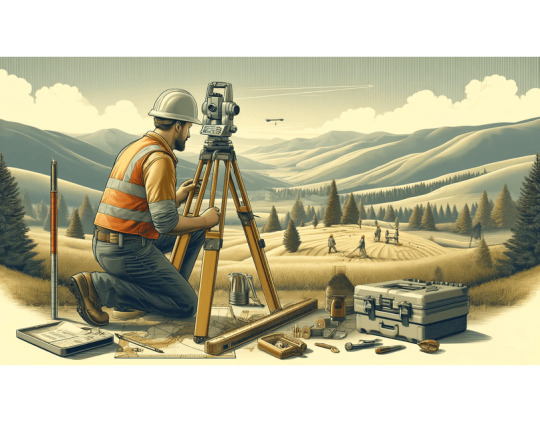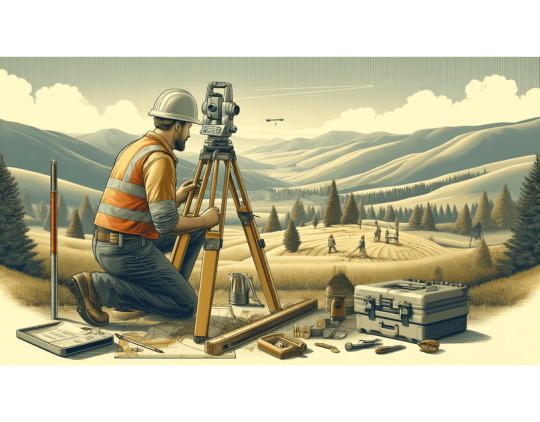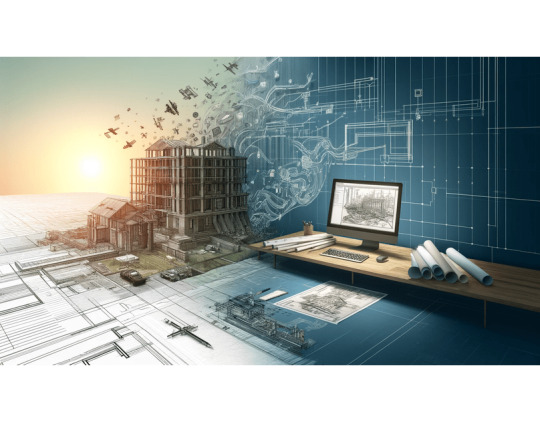Don't wanna be here? Send us removal request.
Text
From Concept to Construction: Building Design Explained

Introduction
Have you ever wondered how towering skyscrapers and complex structures come to life, standing tall amidst the hustle of our cities? Join us as we explore the fascinating process of building design and structural engineering, where every detail is meticulously planned to ensure that these marvels of modern construction are not only visually stunning but also safe, sustainable, and resilient.
This blog offers a glimpse into the minds of engineers and architects as they bring their creative visions to life. From selecting innovative materials to analyzing environmental impact, the journey of designing buildings is a blend of art, science, and technology. Let’s embark on an exciting journey into the world of building design and construction!
What is Structural Design of a Building?
Structural design is a critical aspect of building construction that ensures a structure's stability, strength, durability, and usability. It involves calculating how buildings can safely support all loads throughout their lifespan without sustaining damage. This process also involves selecting the size, type, and materials of structural elements like slabs, columns, beams, foundations, walls, and floors.
Structural design balances cost-efficiency with safety and longevity, making it a vital branch of civil engineering. Now, let's dive into the steps involved in creating these structural designs.
Steps to Make a Structural Design
To better understand each step, we’ll use the example of the Burj Khalifa—the tallest building in the world—as a reference. This will help you visualize the process more clearly.
1. Load Analysis
The first step in structural design is load analysis, where engineers determine all possible forces that might impact the building. This includes wind loads, dead loads (permanent structural weights), live loads (movable weights like people and furniture), and more. Engineers use specialized software such as Tekla, RISA, MiTek, or ETABS to model worst-case scenarios, ensuring that the structure can withstand these forces throughout its life.
For example, when designing the Burj Khalifa, engineers meticulously calculated all potential loads the building would face. Considering Dubai's climate, wind conditions, temperature fluctuations, and the weight of materials like concrete and steel, they planned the structure to ensure its stability and longevity.
2. Structural Analysis
Once potential loads are estimated, engineers move on to structural analysis. This step involves creating a detailed model of the building using advanced software like SAP2000, ETABS, or STAAD Pro. By simulating the calculated loads on this model, engineers can predict how the building will behave in real-world conditions.
For instance, during the design of the Burj Khalifa, engineers used ETABS software to analyze stresses, strains, and deflections. This ensured that the building could safely withstand various loads and environmental conditions, guaranteeing structural safety.
3. Structural Design
The next step is the structural design of individual elements, such as foundations, columns, and slabs. Engineers determine the appropriate sizes, shapes, and materials for these components to ensure they can support the building's loads. This step is crucial for ensuring the overall stability and safety of the structure.
For the Burj Khalifa, a robust structural system was designed to withstand Dubai's environmental conditions. High-strength concrete and steel reinforcements were used to support the building's immense weight, while the reinforced concrete core stabilized it against wind and seismic forces.
4. System Design
After completing the structural design, engineers move on to system design. This step involves organizing the building's structural elements to ensure that all parts work together harmoniously. Engineers design load paths for even load distribution and create strong connections between different components, enhancing the building's overall performance.
In the case of the Burj Khalifa, its large outer frame and central core were carefully designed to distribute loads evenly, reducing wind sway and ensuring the safety and comfort of occupants.
5. Element Detailing
With the structural design in place, engineers then focus on element detailing. This step involves creating detailed drawings and specifications for every structural component. These drawings include dimensions, material requirements, construction methods, and quality standards, ensuring that each component is fabricated accurately and safely.
For the Burj Khalifa, precise detailing of steel profiles, reinforcement patterns, and concrete compositions was essential to meet the design’s stringent criteria for durability and structural integrity.
6. Iterative Design and Drafting
After detailing the elements, the design process becomes iterative. Engineers continuously review and optimize the original designs to ensure they meet safety standards, local regulations, and project goals. This process often involves refining construction drawings and coordinating updates with all parties involved.
7. Construction Administration
The final step in structural design is construction administration, where engineers ensure that the project is built according to the design specifications. This involves site inspections, monitoring construction quality, and addressing any changes or issues that arise during construction. The goal is to ensure that the completed structure meets all safety requirements and the client’s expectations.
During the construction of the Burj Khalifa, engineers meticulously refined the structural system using detailed models and iterative design. By working closely with other disciplines and utilizing Building Information Modeling (BIM), they ensured that the tower’s construction was precise and that its structural integrity was maintained.
Innovation in Structural Design
Innovation plays a crucial role in advancing structural design. The use of new technologies and materials, such as fiber-reinforced polymers, high-strength concrete, and smart materials, significantly enhances structural performance. Building Information Modeling (BIM) allows for seamless collaboration and efficient project management. Sustainability is also a key focus, with energy-efficient designs and eco-friendly construction methods becoming increasingly important.
As innovations continue to evolve, creative solutions ensure that buildings are not only safe and efficient but also capable of withstanding natural disasters like earthquakes and storms. These advancements are helping to shape the future of structural design and the construction industry.
Conclusion
Structural design is a blend of creativity, science, and foresight. By following the steps outlined in this blog, engineers lay the foundation for buildings that embrace innovation, sustainability, and resilience. As we look to the future, we continue to push the boundaries of what is possible, creating structures that inspire, protect, and endure for generations to come. Read our blog for more details: https://www.gsourcedata.com/blog/the-structural-design-process-7-simple-steps
#gsourcetechnologies#architecturedesigns#engineeringdesigns#caddrafting#drafting#structuraldesign#structuraldesignservices
0 notes
Text
This guide provides an overview of land surveying methods, terminology, and types

Did You Know? Modern land surveying techniques can now determine property boundaries with millimeter-level precision. This comprehensive guide delves into the intricate world of land surveying, emphasizing its critical role in civil engineering, real estate, and construction. We’ll explore the core principles, methods, and types of surveys—all supported by real data to provide a well-rounded understanding.
The Role of a Land Surveyor
A land surveyor is a trained professional responsible for performing precise measurements, blending both technical and legal expertise. Their work goes beyond handling advanced tools and data; they must also navigate property laws and regulations. Land surveyors play a pivotal role in resolving property disputes, planning construction projects, and facilitating real estate transactions.
Why Land Surveying Matters
Land surveying is the foundation of various fields, from construction and real estate to environmental management and legal matters. Here’s why it’s so crucial:
Legal Documentation and Property Transactions
Defining Property Boundaries: Accurate land surveys are essential for establishing clear property boundaries, which form the basis for legal descriptions in deeds and official documents.
Resolving Disputes: Surveys provide concrete evidence to resolve property line and land rights disputes, often serving as key evidence in legal proceedings.
Facilitating Transactions: Precise surveys ensure that all parties in a property transaction understand exactly what is being bought, sold, or developed, preventing future conflicts.
Construction and Infrastructure Development
Site Planning: Surveys are integral in determining the best locations for buildings, roads, and infrastructure by accounting for topography and legal boundaries.
Preventing Construction Errors: Accurate surveys help prevent costly construction errors by ensuring that structures are built in the correct locations and comply with zoning laws.
Infrastructure Maintenance: Land surveys document the location of existing infrastructure, monitor conditions, and provide data for future developments.
Environmental Protection and Management
Assessing Environmental Impact: Surveys assess how development projects affect the environment by identifying floodplains, drainage patterns, and other environmental factors.
Planning Sustainable Developments: Survey data helps in planning projects that minimize environmental impact and adhere to conservation regulations.
Managing Natural Resources: Surveys are vital in balancing land use with sustainability, especially in industries like agriculture, mining, and forestry.
With land surveying, precision and data accuracy form the backbone of successful projects in various industries. It’s not just about marking boundaries; it’s about ensuring legal compliance, environmental protection, and sustainable development. Read our blog for more details: https://www.gsourcedata.com/blog/land-surveying-guide-definitions-types-techniques
#gsourcetechnologies#architecturedesign#engineeringdesign#landsurveying#landsurvey#architecturaldesign
0 notes
Text
Blueprints to Buildings: The Ultimate Guide to Architectural Drawings

Introduction
Architectural drawings play a crucial role in shaping the built environment, acting as both artistic expressions and technical guides. These drawings enable clear communication between architects, clients, and builders, ensuring that concepts are accurately transformed into physical structures. This comprehensive article delves into the various types of architectural drawings, explores their creation process, and offers practical guidelines, supported by detailed statistics to deepen understanding.
Types of Architectural Drawings
Site Plans: Site plans are essential for planning and development, showcasing the building in relation to its surroundings. These plans typically include topographical features, nearby structures, roads, and utilities, making them critical for securing construction permits.
Floor Plans: Floor plans are the cornerstone of architectural drawings, comprising approximately 80% of the drawings in construction documents. According to a survey by the American Institute of Architects, well-detailed floor plans can reduce construction errors by up to 30% by providing clear layouts and dimensions, which are vital for precise building execution.
Elevations: Elevations offer a flat view of each side of the building, highlighting its exterior aesthetic. These drawings are key for assessing the visual appeal and understanding the building’s relationship with its environment. Notably, about 60% of aesthetic revisions in architectural projects are influenced by elevation reviews, which guide decisions on material choices and facade treatments.
Sections: Section drawings provide a vertical cut through the building, revealing the internal structures and floors as if the building were sliced open. These drawings are critical for evaluating the flow between different building levels and are heavily used in planning mechanical, electrical, plumbing, and fire protection (MEPF) systems. Research shows that detailed section drawings can enhance the accuracy of internal space planning by over 63%.
Detail Drawings: Detail drawings focus on specific construction elements, such as doors, windows, and connections, providing in-depth insights into these components. They are typically included in both plan and section/elevation views, offering comprehensive information about materials, connections, and technical specifics. Although detail drawings make up only about 10-15% of the total drawing set, they are crucial in reducing on-site errors and minimizing material wastage by clarifying complex construction details.
For more details visit our site: https://www.gsourcedata.com/blog/comprehensive-guide-to-architectural-drawings
#gsourcetechnologies#architecturedesign#engineeringdesigns#architecture#engineering#drafting#drawings
1 note
·
View note
Text
Land Surveying Essentials: Definitions, Techniques, and Types Explained

Did you know that property boundaries may be found with millimeter accuracy using contemporary land surveying techniques? This comprehensive introduction explores the complex field of land surveying and highlights its vital significance in civil engineering, real estate, and construction. Discover the principles, different approaches, and kinds of surveys—all enhanced with real data for a comprehensive comprehension.
The Role of a Land Surveyor
A land surveyor is a skilled professional who performs these measurements with high accuracy. Their role is both technical and legal: they handle complex tools and data while also navigating property laws and regulations. Land surveyors are key in resolving disputes, planning construction, and facilitating property transactions.
Why Land Surveying Matters
Land surveying is fundamental in many areas, including construction, real estate, environmental management, and legal matters. Here’s why it’s so important:
Legal Documentation and Property Transactions:
Defining Property Boundaries: Accurate land surveys are essential for setting clear property boundaries, which are crucial for legal descriptions in deeds and other documents.
Resolving Disputes: Surveys provide factual evidence to settle disputes over property lines and land rights, often serving as critical evidence in legal settings.
Facilitating Transactions: Precise surveys ensure all parties in a property transaction understand exactly what is being bought, sold, or developed.
Construction and Infrastructure Development:
Site Planning: Surveys determine optimal locations for buildings, roads, and infrastructure, considering topography and legal boundaries.
Preventing Construction Errors: Surveys help avoid costly mistakes by ensuring structures are built correctly and comply with zoning laws.
Infrastructure Maintenance: For existing infrastructure, surveys are used to record locations, monitor conditions, and assist in future developments.
Environmental Protection and Management:
Assessing Environmental Impact: Surveys evaluate how development projects affect the environment, including identifying flood plains and understanding drainage patterns.
Planning Sustainable Developments: Data from surveys aids in planning projects that minimize environmental impact and adhere to conservation regulations.
Managing Natural Resources: Surveys are crucial for managing land use in agriculture, mining, and forestry, ensuring a balance between economic benefits and environmental sustainability.
Read our blog for more details: https://www.gsourcedata.com/blog/land-surveying-guide-definitions-types-techniques
#gsourcetechnologies#architecturedesigns#engineeringdesign#land survey#land surveyor#engineeringdesigns
2 notes
·
View notes
Text
Transforming Civil Engineering: The Impact of CAD on Design and Efficiency

Introduction
Computer-Aided Design (CAD) has revolutionized civil engineering, transforming how projects are planned, designed, and executed. This technological tool has not only enhanced design accuracy but also improved the efficiency and productivity of civil engineering projects. CAD's applications in civil engineering span drafting, modeling, analysis, and project management, making it indispensable in modern civil engineering practices.
What is CAD?
CAD refers to the use of computer technology for design and design documentation. CAD software replaces manual drafting with an automated process. Engineers, architects, and construction professionals use CAD software to create precision drawings or technical illustrations in 2D or 3D, which can be used to build and manufacture complex structures and systems.
Historical Perspective and Evolution
The introduction of CAD software in the late 1960s constituted a significant technological leap for design disciplines. Initially, CAD systems were predominantly used in aerospace and automotive industries due to their high cost and operational complexities. By the 1980s, as computer technology became more accessible and user-friendly, CAD applications began to significantly influence the field of civil engineering. This transition marked a shift from traditional drafting methods to a more integrated and dynamic approach to design and construction.
Applications of CAD in Civil Engineering
CAD drafting has become a fundamental component in civil engineering, offering a range of applications that enhance the planning, design, and execution of various projects. Here’s a more detailed look at these applications:
1. Architectural Design
CAD drafting is extensively used in the creation of architectural plans, including the layout of buildings, structures, and other facilities. It allows for precise measurements and detailed representations of spaces, helping architects and engineers optimize design aesthetics and functionality. This application ensures that every architectural element is perfectly scaled and aligned according to project specifications.
2. Structural Engineering
In structural engineering, CAD drafting is crucial for designing the skeleton of buildings and other structures. It helps engineers calculate the correct dimensions, strengths, and materials needed to ensure safety and compliance with building codes. CAD models can simulate how structures withstand stresses and strains, helping to predict potential failure points and reinforce them in advance.
3. Road and Highway Design
CAD drafting simplifies the complex task of designing roads and highways. It allows engineers to map out precise routes, considering topography, traffic flow, and environmental impacts. CAD tools enable the creation of 2D and 3D models of road systems, which include details such as lane specifications, intersections, and access points, ensuring optimal traffic management and safety.
4. Utilities and Pipeline Design
For projects involving water supply, sewage systems, and pipelines, CAD drafting is indispensable. It provides detailed schematics and installation plans that help manage the extensive network of pipes and conduits required in these systems. CAD ensures these utilities are efficiently integrated into the overall project plan, avoiding conflicts and ensuring compliance with environmental standards.
5. Land Development and Site Planning
CAD drafting aids in the comprehensive planning and development of land. This includes plotting out land divisions, designing landscape elements, and planning the placement of buildings and other structures. CAD tools help civil engineers and planners assess the best use of a site, taking into account geographical data and zoning laws, which are crucial for sustainable development.
6. Environmental Engineering
In environmental engineering, CAD drafting is used to design solutions that mitigate environmental impacts. This can include everything from erosion controls and stormwater management systems to the remediation of contaminated sites. CAD models help engineers visualize and simulate environmental systems and their interactions with human-made structures, enhancing the effectiveness of environmental protection measures.
7. Surveying
CAD is crucial in surveying for capturing and analyzing geographical data. This data informs all phases of civil engineering projects, from initial planning to final construction. CAD software helps in creating detailed site models from the survey data, providing a precise base for all further engineering work.
8. Project Documentation
Every civil engineering project requires comprehensive documentation, from initial designs and specifications to as-built drawings and maintenance plans. CAD drafting systems facilitate the creation of these documents, ensuring they are accurate and up-to-date. This supports project management and execution and ensures compliance with legal and regulatory requirements.
9. Integration with BIM
CAD drafting is often integrated with Building Information Modeling (BIM) systems, representing a further evolution of traditional CAD. BIM incorporates detailed information about every component of a building or structure, creating a more dynamic 3D modeling process that spans the entire lifecycle of a project. This integration enhances collaboration among all stakeholders, improving the decision-making process throughout the project's phases.
CAD drafting in civil engineering is pivotal for achieving precision, efficiency, and effectiveness in project implementation. It supports a range of critical activities, from the foundational planning stages to the detailed final design and maintenance plans, embodying a central tool in the civil engineering field. Read our blog for more information: https://www.gsourcedata.com/blog/how-cad-improves-design-effectiveness-and-work-output
#gsourcetechnologies#architecturedesigns#engineeringdesigns#cadservices#caddrafting#civil engineering
1 note
·
View note
Text
Deciding Between LiDAR and Photogrammetry for Aerial Surveys

Deciding between LiDAR and photogrammetry for land surveying can be challenging for professionals in various fields. Choosing the wrong method can lead to costly delays, inaccurate data, or even project failure. Both technologies have their own advantages and drawbacks, making it essential to select the one that best fits the specific application.
Aerial surveying is crucial in industries such as mapping, forestry, urban planning, and environmental science. It involves capturing accurate data about the Earth's surface from the air. Two primary technologies are used: Light Detection and Ranging (LiDAR) and photogrammetry. Each has unique strengths and limitations, making them more suitable for different applications.
LiDAR Technology: LiDAR (Light Detection and Ranging) is a remote sensing technique that uses pulsed laser light to measure distances to the Earth's surface. By emitting thousands of light pulses and recording their reflections, LiDAR creates precise, 3D representations of the Earth's shape and surface features.
Photogrammetry: Photogrammetry is the science of extracting accurate information about physical objects and environments from photographic images. By recording, measuring, and analyzing patterns in electromagnetic radiation, photogrammetry transforms images into reliable data about the size, shape, and position of objects. Read our blog for more details: https://www.gsourcedata.com/blog/lidar-vs-photogrammetry
#gsourcetechnologies#architecturedesign#engineeringdesign#lidar#photogrammetry#lidarservices#photogrammetryservices
0 notes
Text
From Concepts to Models: A Quick Dive into CAD Drafting

What exactly is CAD drafting, and how can it impact your creative pursuits? Look no further - this comprehensive guide has got you covered. From its humble beginnings to its mind-boggling applications, we'll delve deep into the mechanics and benefits of CAD drafting, providing a unique perspective that you won't find anywhere else. Whether you're a beginner or a seasoned professional, join us on this exciting journey and discover the endless possibilities that CAD drafting has to offer.
What is CAD?
CAD, also known as Computer-aided Design is a software or a digital tool that architects, engineers, and designers use to create, modify, render, and produce 2D or 3D models of real-life objects. This software helps the designers and engineers in different ways benefiting them in their productivity and the quality of the results.
It allows them to modify, analyze, create, edit, and share these 2D and 3D designs. Different industries have benefited from this software. Now, as we look at what CAD is all about, let us first know how this software has developed over the years.
Evolution of CAD Software
Through dramatic changes over more than 50 years, computer-aided design (CAD) has seen a remarkable journey of development. The development of CAD software was a pivotal point in the history of design and engineering, spearheaded by Patrick Hanratty, who is frequently credited as the creator of CAD services. With time, 3D modeling features were added to CAD software, which was initially primarily focused on 2D rendering. The introduction of microcomputers in the 1980s brought about a significant change that accelerated the development of CAD software.
During this time, AutoCAD and AutoDesk became important players and changed the face of computer-aided design. The first IBM PCs were released at the same time, which increased CAD technology acceptance even more. Features like wireframe design, surface design, solid modeling, and parametric modeling were added to CAD software with each upgrade. Users now enjoy increased accuracy and efficiency thanks to these technological innovations that have continually transformed the design process. These days, computer-aided design (CAD) drawing is a representation of innovation that dynamically combines creativity and technology.
Let us now look forward to knowing more about CAD and CAD Drafting.
What is CAD Drafting?
CAD drafting involves creating plans and designs utilizing CAD software and technology, eliminating the need for manual hand-drawn sheets and paper. Designers get a digital space to innovate, ideate, modify, and share designs. It also makes it easier to save and use the designs later.
CAD Drafting also makes it easier for the clients to understand the design clearly as it offers 3D modeling. 3D modeling of a design gives a better understanding of what the actual product will look like. Also, CAD Drafting can make different gaming characters and develop the game landscape. Now that we know what CAD Drafting is, let us understand some of the basic principles of CAD Drafting.
Basic principles of CAD drafting
There are some things that one can use and keep in mind while designing using CAD Software. These are the basic principles that one needs to understand before starting their CAD Drafting journey and they are as follows -
CAD Drafting can be used from the perspective of Designing from the end usage of the product. This helps in understanding and designing the product to its fine details. Once this is merged with manufacturing, it helps in building the product in a better way.
CAD allows the innovation of new ideas and also helps in collaboration with different units like manufacturers, engineers, stakeholders, and more. These innovations in ideas help the client to get different visuals of their product. It allows us to have a different perspective on the design and product.
Now, as we have understood the basics before getting into CAD Drafting there are certain go-to and simple tools one can use at the beginning of their learning about the software. The Basic Tools that are useful in CAD are -
Drawing Tools: Drawing tools are something that lets you draw the shapes in the design. Some of the basic drawing tools that one can use are the circle, line, rectangle, and arc tools. These tools help in shaping basic shapes like squares, circles, triangles, rectangles, and more.
Modification/Editing Tools- These tools help modify the design and edit it in a precise way. The different modification or editing tools that one can use are the Trim, Extend, Fillet, Move, Scale, or Rotate tools. Each has a different use in the designing process.
Layer Management Tools- There are different layers in the making process of a design. These layers can sometimes create confusion and might mislead the design, Thus there are certain layer management tools like Layer lock/unlock and different layer properties. This helps in managing the layers of the design in a better way.
Snapping Tools- These are the tools that help you snap the particular point of the design be it endpoint, midpoint, or intersection.
Saving and Exporting Tools - The basic save and export tool helps you save the work and export it in different formats to different spaces like Gmail, Manufacturing unit, as an image, or any other format.
If you're eager to dive deeper into the world of CAD drafting, including its history, tools, and future trends, check out our detailed blog. We cover everything from the basics of CAD to the latest software advancements and industry applications. Whether you're just starting out or looking to expand your skills, our comprehensive guide is packed with valuable insights. Discover more by visiting our blog here: https://www.gsourcedata.com/blog/cad-drafting-everything-you-need-to-know
#caddrafting#architecturedesign#engineeringdesigns#cad#drafting#engineeringdesign#gsourcetechnologies
1 note
·
View note